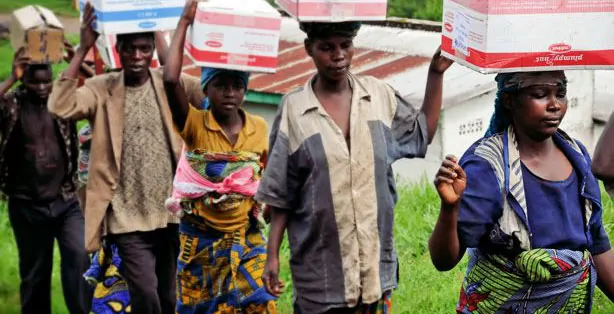
Every parent I talk to here in eastern Congo is struggling to feed their family.
Many children are malnourished. Babies have bleached hair caused by malnutrition. A large family of seven is surviving on a handful of sweet potatoes and assistance provided by aid agencies. A young girl has the skin of an old woman.
All around the world we’re feeling the effects of the food crisis. In some places this means cutting down on luxury desserts, eating out less or doing our weekly shop at a budget supermarket.
In other places, it’s a genuine crisis of one of our most basic of needs—food.
We all enjoy food so much … sweet apple crumble with soft Cornish ice-cream, delicate Parma ham wrapped around a fresh ripe melon, a grilled fish straight from the sea, with a squirt of lemon and a dollop of butter.
It’s hard to understand how one of our most important commodities has become so expensive, because the causes are complicated. In Kenya, for example, there’s drought coupled with the after-effects of the post-election violence a year ago.
In eastern Congo, where I am, the causes are different. Here, the soil is rich and fertile, there is plenty of rain, a beautiful mountain climate allows farmers to plant and harvest all year round. The problem is conflict.
In a rebel-held area on the border of Uganda, the price of bananas has increased dramatically. A big bunch used to cost one or two dollars, now you pay an extortionate eight dollars. When families heard gun shots in October 2007 and were told of soldiers going into homes and killing their neighbors, they fled their village and land.
“When we run, we run for our lives,” 32-year-old Ansila Mukamazera says. “We leave everything behind, including our crops.”
Everyone in this village grows their own food, but almost all the villagers fled when it was attacked. In October last year, people began to return home but they found their land and homes destroyed.
“When we returned our crops had been stolen,” Mukamazera says. “Cows were grazing in the fields. Nothing remained.”
Now there is little food at the market and what there is, is too expensive. Mukamazera’s 3-year-old son has a protruding belly because of worms.
World Vision is going into communities, identifying those who are malnourished and treating them until they are healthy again.
But this struggle for a daily meal is going to continue until July when the village hopes to harvest the crops now cultivating in the fields.
“Our fear is that fighting will erupt again,” Mukamazera says. “We are ready to flee if anything happens again.”
Seeing the young peas sprouting healthily in nearby fields and banana trees strong and robust all around me, I appreciate in a new way the value of food. With peace comes not just stability but productive farms, nutritious meals and healthy children.
Let’s pray the peace talks for the Democratic Republic of Congo, which continue in Kenya, make this happen.
Anna Ridout is a senior emergency communications officer for World Vision U.K. working in the Democratic Republic of Congo.






















